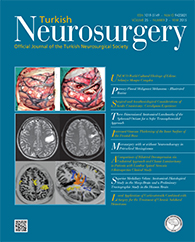2The Second Affiliated Hospital of Xinjiang Medical University, Department of Neurosurgery, Urumqi, China DOI : 10.5137/1019-5149.JTN.8670-13.1 AIM: This study aimed to investigate the operative procedure for neuroendoscope-assisted microscopic resection of petroclival meningioma to improve prognosis.
MATERIAL and METHODS: Twelve patients with petroclival meningioma who had undergone neuroendoscope-assisted microscopic resection at the Department of Neurosurgery, First Affiliated Hospital of Xinjiang Medical University were selected. In addition, 12 patients with petroclival meningioma who had undergone microscopic surgery were used as control. Clinical data from the 24 cases of petroclival meningioma were analyzed.
RESULTS: For the neuroendoscope-assisted group, six, five, and one cases were respectively subjected to total resection, subtotal resection, and most resection. For the microscopic surgery group, two, three, and seven cases were respectively subjected to total resection, subtotal resection, and most resection. Both the total and subtotal resection rates of petroclival meningioma in the neuroendoscope-assisted group were significantly higher than those in the microscopic surgery group (p < 0.05). No difference was observed for short-term and long-term complications (p > 0.05) between the two groups.
CONCLUSION: Neuroendoscope-assisted microscopic resection for petroclival meningioma can improve the total and subtotal resection rates of the tumor. Moreover, this method does not increase postoperative short-term and long-term complications.
Keywords : Petroclival meningioma, Microsurgical operation, Neuroendoscopy




